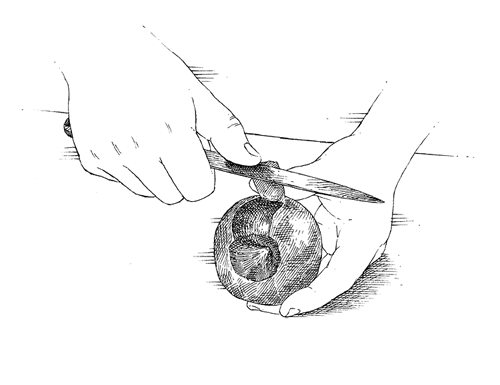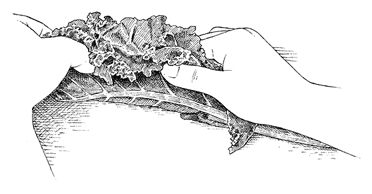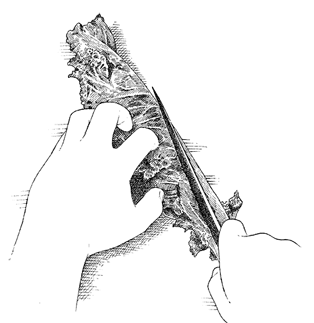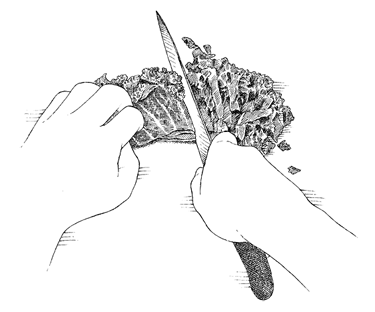The Cook's Illustrated Cookbook (121 page)
Read The Cook's Illustrated Cookbook Online
Authors: The Editors at America's Test Kitchen
Tags: #Cooking


1.
Place cored tomatoes in pot of boiling water. Boil until skins split and begin to curl around core area, 15 seconds for very ripe tomatoes or up to 30 seconds for underripe ones. Remove tomatoes from water with slotted spoon and place in bowl of ice water.

2.
Let tomatoes cool for 1 minute. Using paring knife, peel skins from the flesh starting at curled edges at core.
![]() WHY THIS RECIPE WORKS
WHY THIS RECIPE WORKS
We wanted a one-pot approach to turning winter greens like kale and collards tender, without spending hours or leaving them awash in liquid. We sautéed half of the greens before adding the rest with a little bit of liquid and covered the pot. When the greens almost had the tender-firm texture we wanted, we removed the lid to allow the liquid to cook off. With the texture right where we wanted it, all we had to do was come up with a few flavorful ingredients to add to the pot.
See “PREPARING GREENS FOR BRAISING” illustrations that follow recipe.
SERVES 4
For the best results, be sure the greens are fully cooked and tender in step 1 before moving on to step 2.
3 | tablespoons olive oil |
1 | onion, chopped fine |
5 | garlic cloves, minced |
¹⁄ | teaspoon red pepper flakes |
2 | pounds kale or collard greens, stemmed and leaves chopped into 3-inch pieces |
1 | cup low-sodium chicken broth |
1 | cup water |
Salt and pepper | |
2–3 | teaspoons lemon juice |
1.
Heat 2 tablespoons oil in Dutch oven over medium heat until shimmering. Add onion and cook, stirring frequently, until softened and beginning to brown, 4 to 5 minutes. Add garlic and pepper flakes and cook until garlic is fragrant, about 1 minute. Add half of greens and stir until beginning to wilt, about 1 minute. Add remaining greens, broth, water, and ¹⁄
4
teaspoon salt. Quickly cover pot and reduce heat to medium-low. Cook, stirring occasionally, until greens are tender, 25 to 35 minutes for kale and 35 to 45 minutes for collards.
2.
Remove lid and increase heat to medium-high. Cook, stirring occasionally, until most of liquid has evaporated (bottom of pot will be almost dry and greens will begin to sizzle), 8 to 12 minutes. Off heat, stir in 2 teaspoons lemon juice and remaining 1 tablespoon oil. Season with salt, pepper, and lemon juice to taste and serve.
Cook 6 slices bacon, cut into ¹⁄
4
-inch pieces, over medium heat until crisp, 5 to 7 minutes. Transfer bacon to paper towel–lined plate and pour off all but 2 tablespoons fat. Use rendered fat in place of 2 tablespoons olive oil, substitute 1 red onion, halved and cut into ¹⁄
4
-inch slices, for minced onion, and 3 to 4 teaspoons cider vinegar for lemon juice. Stir reserved bacon into greens before serving.
Substitute 2 teaspoons grated fresh ginger and 1 teaspoon curry powder for red pepper flakes and one 14-ounce can coconut milk for water. Substitute 2 to 3 teaspoons lime juice for lemon juice and sprinkle greens with ¹⁄
3
cup toasted cashews before serving.
Heat oil as directed in step 1, then add 8 ounces Spanish chorizo sausage, cut into ¹⁄
4
-inch-thick half-moons, and cook until lightly browned, 4 to 6 minutes. Transfer chorizo to paper towel–lined plate. Proceed with recipe, cooking onion and garlic in remaining oil and substituting 1¹⁄
2
teaspoons ground cumin for red pepper flakes. Stir in reserved chorizo before serving.
When prepping hearty greens like collards or kale for our Braised Winter Greens, cutting out the central rib from each leaf individually can be tedious and time-consuming. Here’s a way to speed up the process.

1.
Stack 3 or 4 leaves on top of each other, large to small, aligning their central ribs.

2.
Fold stack of greens in half along the central rib.

3.
Trim central rib using one knife stroke. Repeat with remaining leaves.

4.
Chop leaves crosswise into 3-inch pieces.
![]() WHY THIS RECIPE WORKS
WHY THIS RECIPE WORKS
Baby spinach is convenient—no stems to remove or grit to rinse out—but cooking often turns the tender greens into a watery, mushy mess. We were determined to find a method for cooking baby spinach that would give us a worthwhile side dish. Parcooking the spinach in the microwave turned out to be the best way to help the vegetable release plenty of liquid. We pressed the microwaved spinach against a colander to eliminate more water, coarsely chopped it, and pressed it again. Then all we had to do was quickly sauté it. We then combined the spinach with a few complementary flavors and appealing textures to finish the dish.
SERVES 4
If you don’t have a bowl large enough to accommodate the entire amount of spinach, cook it in a smaller bowl in two batches. Reduce the water to 2 tablespoons per batch and cook the spinach for about 1¹⁄
2
minutes.
18 | ounces baby spinach |
¹⁄ | cup water |
2 | tablespoons plus 2 teaspoons extra-virgin olive oil |
4 | garlic cloves, sliced thin crosswise |
¹⁄ | teaspoon red pepper flakes |
¹⁄ | cup golden raisins |
Salt | |
2 | teaspoons sherry vinegar |
¹⁄ | cup slivered almonds, toasted |
1.
Place spinach and water in large bowl. Cover bowl with large dinner plate (plate should completely cover bowl and not rest on spinach). Microwave until spinach is wilted and decreased in volume by half, 3 to 4 minutes. Remove bowl from microwave and keep covered for 1 minute. Carefully remove plate and transfer spinach to colander. Using back of rubber spatula, gently press spinach against colander to release excess liquid. Transfer spinach to cutting board and chop coarse. Return spinach to colander and press again.
2.
Heat 2 tablespoons oil, garlic, pepper flakes, and raisins in 10-inch skillet over medium-high heat. Cook, stirring constantly, until garlic is light golden brown and beginning to sizzle, 3 to 6 minutes. Add spinach to skillet, using tongs to stir and coat with oil. Sprinkle with ¹⁄
4
teaspoon salt and continue stirring with tongs until spinach is uniformly wilted and glossy green, about 2 minutes. Sprinkle with vinegar and almonds; stir to combine. Drizzle with remaining 2 teaspoons oil and season with salt to taste. Serve immediately.
